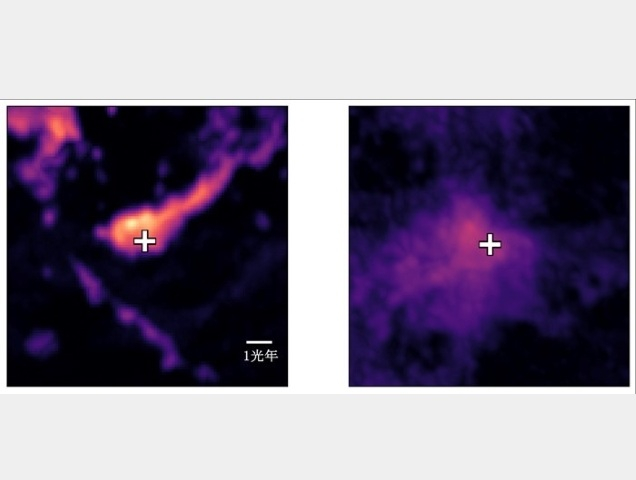Research News
Feb 20, 2025
- Science
In ancient stellar nurseries, some stars are born of fluffy clouds
Observations of the Small Magellanic Cloud: insights into star formation in early-universe-like environments
Example of a filamentary (left) and fluffy (right) molecular cloud in the Small Magellanic Cloud captured by the ALMA telescope
The radio waves emitted by carbon monoxide molecules are shown in color. The brighter the color, the stronger the radio emission. The crosses in the middle indicate the presence of giant baby stars. The left figure shows a molecular cloud with a filamentary structure, and the right figure shows an example of a molecular cloud with a fluffy shape. Scale bar: 1 light-year.
Credit: ALMA (ESO/NAOJ/NRAO), Tokuda et al.

How are stars born, and has this process always been the same?
Stars form in regions of space known as stellar nurseries, where high concentrations of gas and dust coalesce to form a baby star. Also called molecular clouds, these regions can be vast, spanning hundreds of light-years and forming thousands of stars. And while we know much about the life cycle of a star thanks to advances in technology and observational tools, precise details remain obscure. For example, did stars form this way in the early universe?
Publishing in The Astrophysical Journal, researchers from Kyushu University, in collaboration with Osaka Metropolitan University, have found that in the early universe, some stars may have formed in “fluffy” molecular clouds. The results were obtained from observations of the Small Magellanic Cloud and may provide a new perspective on star formation throughout the history of the universe.
In our Milky Way galaxy, the molecular clouds that facilitate star formation have an elongated “filamentary” structure about 0.3 light-years wide. Astronomers believe that our Solar System was formed in the same way, where a large filamentary molecular cloud broke apart to form a stellar egg, also called a molecular cloud core. Over hundreds of thousands of years, gravity would attract gases and matter into the cores to create a star.
The team set their sights on the Small Magellanic Cloud (SMC), a dwarf galaxy near the Milky Way about 20,000 light-years from Earth. The SMC contains only about one-fifth of the heavy elements of the Milky Way, making it very close to the cosmic environment of the early universe, about 10 billion years ago. However, the spatial resolution for observing the molecular clouds in the SMC was often insufficient, and it was unclear whether the same filamentary structure could be seen at all.
Fortunately, the ALMA radio telescope in Chile was powerful enough to capture higher-resolution images of the SMC and determine the presence or absence of filamentary molecular clouds.
“In total, we collected and analyzed data from 17 molecular clouds. Each of these molecular clouds had growing baby stars 20 times the mass of our Sun,” explains Kazuki Tokuda, a Post‐doctoral Fellow at Kyushu University’s Faculty of Science and first author of the study. “We found that about 60% of the molecular clouds we observed had a filamentary structure with a width of about 0.3 light-years, but the remaining 40% had a ‘fluffy’ shape.”
“We have defined a ‘fluffy’ molecular cloud that is different from the filamentary molecular clouds that have been discovered in the Milky Way and other galaxies and have been able to identify its characteristics in the Small Magellanic Cloud,” added Yuri Kunitoshi, a student in the Graduate School of Science at Osaka Metropolitan University.
“To elucidate the star formation process in the early universe, about 10 billion years ago, we need to conduct further research in various galaxies,” she said.
Funding
National Astronomical Observatory of Japan ALMA (2022-22B), Japan Society for the Promotion of Science (JP18H05440, JP19K14760, JP20H05645, JP21H00049, JP21H00058, JP21H01145, JP21K13962, and JP23H00129)
Paper information
Journal: The Astrophysical Journal
Title: ALMA 0.1 pc View of Molecular Clouds Associated with High-Mass Protostellar Systems in the Small Magellanic Cloud: Are Low-Metallicity Clouds Filamentary or Not?
DOI: 10.3847/1538-4357/ada5f8
Authors: Kazuki Tokuda, Yuri Kunitoshi, Sarolta Zahorecz, Kei E. I. Tanaka, Itsuki Murakoso, Naoto Harada, Masato I. N. Kobayashi, Tsuyoshi Inoue, Marta Sewilo, Ayu Konishi, Takashi Shimonishi, Yichen Zhang, Yasuo Fukui, Akiko Kawamura, Toshikazu Onishi, and Masahiro N. Machida
Published: 20 February 2025
URL: https://doi.org/10.3847/1538-4357/ada5f8
Contact
Toshikazu Onishi
Graduate School of Science
Email: tonishi[at]omu.ac.jp
*Please change [at] to @.
SDGs
